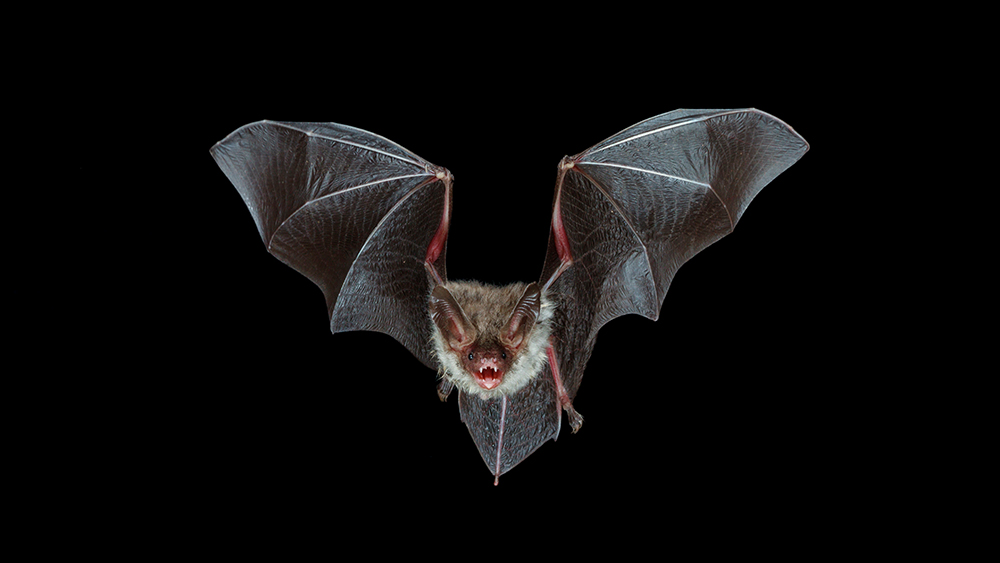Bats have the amazing ability to accurately and consistently detect the speed of sound.1 This enables them to employ a complex system of echolocation in the dark of night to find food in mid-flight and to avoid slamming into trees. But unlike processes in many animals that use a system of learning such as birds singing or lions hunting, bats seem to be hard-wired in their ability to echolocate from birth. Research has now shown that this ability is based on an innate system of speed-of-sound detection.2
Every organism must reliably and accurately sense its environment to survive and reproduce. These complex sensory systems involve features that are innate and unalterable, or hard-wired, and enable immediate function of the overall process. Other aspects of creatures contain a learning component that allows for more flexible adaptation similar to how man-made machine learning algorithms function to develop and fine tune behavior.
As Bats fly around at night, they emit high-pitched signals that reflect off distant objects. The echoes from these are then translated by the bat’s echolocation system based on the time it takes the echo to return, giving an accurate measure of distance. Depending on air conditions (e.g. temperature, humidity), sound waves can move faster or slower and the bat is able to adjust and accommodate for this within a specified range.
To study the nature of this system, researchers at Tel Aviv University in Israel trained eight adult bats to fly to a perch within a dark chamber pumped full of abnormally high levels of oxygen and helium. Because helium is less dense than other gases in the atmosphere, sound waves can travel much faster through it. The researchers discovered that the helium-rich air interfered with the timing of the echolocation, which caused the bats to fall short of landing on the perch. While this was to be expected at the start of the study, the bats never learned to adjust.
The researchers were shocked, thinking the bats would be able to eventually adjust their behavior. The scientists then raised 11 bats from birth, and when they were mature enough to fly, they repeated the study. Despite the helium-rich environment that the bat pups were subjected to, none of them could accurately sense the distance to the perch when high levels of helium were present.
First, these experiments showed that the environment had no magical selective power over the bats to evolve them to adjust their systems to unnatural helium levels. But most importantly, the experiments did reveal that the bats had an innate reference for the speed of sound under natural atmospheric conditions that could at the same time allow them to adjust for reasonable differences in temperature and humidity. In other words, the findings ultimately pointed to the handiwork of an omnipotent Engineer (God the Creator), in which bats have a specific design plan constructed to solve a specific set of challenges.
References
1. Tomkins, J.P. 2019. Complex Creature Engineering Requires a Creator. Acts & Facts. 48 (8).
2. Amichai, E. and Y. Yovel. 2021. Echolocating bats rely on an innate speed-of-sound reference. Proceedings National Academy of Sciences USA. 118 (19): e2024352118.
*Dr. Tomkins is Director of Research at the Institute for Creation Research and earned his doctorate in genetics from Clemson University.

Innate Speed-of-Sound Engineering Revealed in Bats
The Latest
Florida Fossil Shows Porcupines Have Always Been Porcupines
The porcupine is an animal (rodent) that one does not soon forget. It is armed with formidable quills that deter even the hungriest predators. What...
Webb Telescope Discovers Another Record-Breaking Galaxy
Astronomers using the James Webb Space Telescope have recently confirmed that two galaxies are extremely distant, with one becoming the new record holder...
CREATION PODCAST
The Power of Film & Video: Reaching All Ages with Truth | The...
Is there a place for the use of film and video within Christianity? If so, how can we leverage this powerful tool to reach viewers of all ages...
Scaly Skin on a Feathered Dinosaur?
Fossil experts from University College Cork in Ireland took stunning images of Psittacosaurus skin. The dinosaurs’ belly shows patches of skin...
T. rex Not as Smart as Thought
Have movies and most conventional paleontologists got it all wrong? T. rex and other theropod dinosaurs (the meat-eaters) are often portrayed as intelligent...
June 2024 ICR Wallpaper
"For by grace you have been saved through faith, and that not of yourselves; it is the gift of God." (Ephesians 2:8 NKJV)
ICR June...
A “Just-so” Story About Ancient Genes
An evolutionary website recently published “a groundbreaking study” that supposedly identifies a basic, uncomplicated, “simple”...
CREATION PODCAST
Dinosaurs with Bird Brains??? | The Creation Podcast: Episode...
Evolutionists claim that birds are descended from dinosaurs. A feature that is often cited as linking these two types of creatures is the brain....
CREATION.LIVE PODCAST
From Ruins to Revelation: Truths Revealed Through Biblical Archaeology...
The Bible is full of people and places that are seemingly lost to time, but through the field of archaeology, new finds are shedding light on the incredible...
Bergmann’s Rule Falsely Refuted
A recent study of dinosaur sizes claims to break Bergmann’s rule.1 Bergmann’s rule was named after biologist Carl Bergmann, who...































